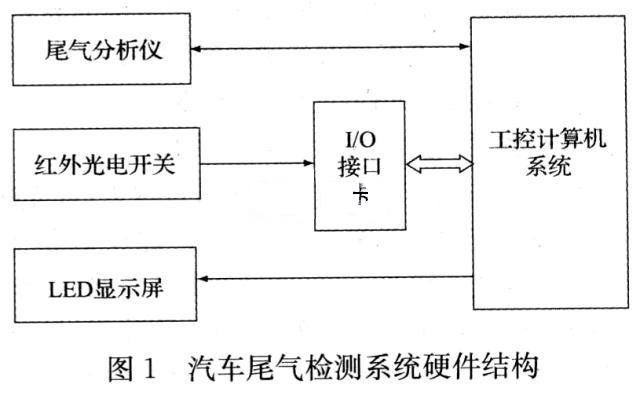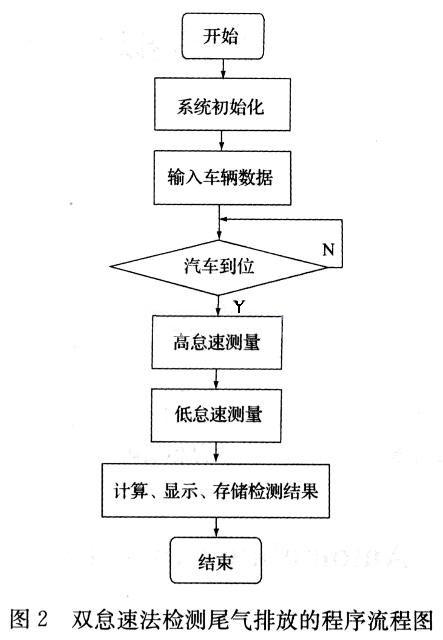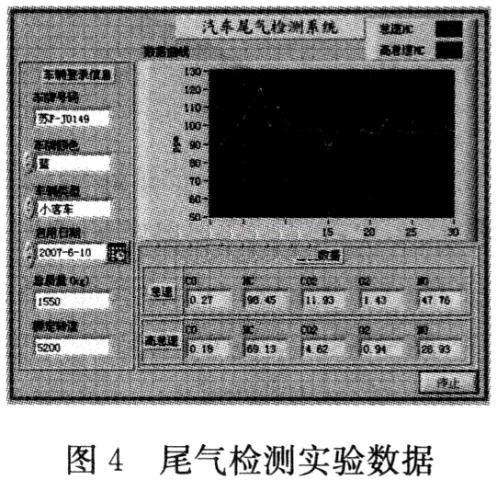Automobile Exhaust Gas Detection System Based on Virtual Instrument Technology
Abstract: In order to monitor and prevent environmental pollution caused by automobile exhaust emissions, this paper introduces a vehicle exhaust detection system based on virtual instrument technology. First introduced the composition structure and working principle of the detection system, put forward a graphical programming language LabVIEw8.2 launched by the American NI company as the development environment, using the VS5067-5 produced by the German Siemens company as the exhaust gas analyzer for automobile exhaust gas detection System design method. In particular, the LabVIEW8.2 implementation of industrial control computer and VS5067-5 serial communication program is introduced in detail. The actual test results show that the method is convenient and practical, and has the value of popularization and application.
0 Preface
In recent years, with the rapid development of China's social economy and the continuous improvement of people's living standards, the car ownership has increased significantly. While cars bring convenience to people's daily lives, they also bring serious environmental problems. Harmful gases such as CO and HC compounds in automobile exhaust have become the main source of air pollution. Therefore, monitoring and preventing the exhaust pollution of automobiles is an important task to control environmental pollution.
To control the exhaust pollution of motor vehicles, the first thing is to do a good job of testing. In China, since 1999, a series of corresponding regulations have been formulated to strictly control the emission of automobile exhaust. In 2005, GB 18285-2005 "Limited emission limits and measurement methods for exhaust pollutants from ignited engines" was promulgated. In addition to the measurement methods for exhaust pollutants under idling and high idling conditions, the standard In addition to the requirements, the emission limits of exhaust pollutants for each type of vehicle are clearly defined.
The main detection parameters of automobile exhaust pollutants are: CO (carbon monoxide), HC (hydrocarbon), CO2 (carbon dioxide), O2 (oxygen), NO (nitrogen monoxide) and so on.
1 Composition of the detection system
The hardware structure of automobile exhaust gas detection system based on virtual instrument technology is shown in Figure 1.

The detection system is mainly composed of exhaust gas analyzer, I / O interface card, infrared photoelectric switch, LED Display Screen and industrial control computer. The exhaust gas analyzer selects the VS5067-5 automobile exhaust gas analyzer of German Siemens. The core component of the instrument is the infrared optical sensor of Siemens. Its working principle is based on the characteristic absorption band and frequency of different gases. Spectral bands around the frequency produce strong absorption. Based on the absorption intensity of the infrared spectrum of the gas, the composition and content of automobile exhaust are detected and analyzed. The instrument can detect the concentration of five gases such as CO, HC, CO2, O2, and NO in the automobile exhaust gas and the working parameters of the engine such as engine oil temperature and speed. The line interface is connected with the industrial control computer, and can receive measurement commands and output test results through the serial port.
The extended I / O interface card on the industrial control computer is mainly used to receive the on and off status of the infrared photoelectric switch, and is used to judge whether the inspected vehicle is in place. The infrared photoelectric switch adopts Omron E3JK-5M type, and its infrared photoelectric distance is 5m. Infrared emitting photocells and infrared receiving photocells are installed on both sides of the car detection line. When the infrared emission tube is not blocked, the receiving photocell is normally closed. When the vehicle under inspection runs to the detection station to block the infrared emission photocell, the receiving photocell is in the off state, and the receiving photocell is open and closed. Indicates whether the vehicle is in place.
The LED display screen is used to display the testing process information and testing results. The pilot and the exhaust emission inspector can perform corresponding operations under the guidance of the information displayed on the LED display.
The working process of the exhaust gas detection system is as follows: when the vehicle is logged on-line for detection, the industrial control computer sends out a vehicle incoming message, prompting the detected vehicle to enter the detection station. When the industrial control computer detects that the receiving photocell is in the off state, it means that the vehicle is in place and the exhaust gas detection can be started. The testing procedures will be carried out in accordance with the measurement methods specified in the national standard GB18285-2005. During the detection process, the exhaust emission inspector inserts the sampling probe into the exhaust pipe of the vehicle under inspection according to the instructions of the LED display screen, and connects the speed measurement clamp to the relevant parts of the engine as required; the exhaust gas analyzer receives the command of the industrial control computer from the serial port, Collect exhaust pollutants; the pilots operate the car to enter the rated speed, high idle speed, idle speed and other states according to the instructions on the LED display screen, and cooperate with the exhaust gas analyzer to complete the exhaust gas emission measurement according to the test procedure.
2 Testing software design
Software is the key to virtual instruments. Design a virtual instrument system, after the hardware platform is determined, you can design different software modules to achieve different functions. The application software of the automobile exhaust gas detection system is developed using NI's graphical programming language LabVIEW 8.2 and is modular in design. The flow chart of the procedure for detecting exhaust emissions according to the double idle speed method is shown in FIG. 2.
The execution process of the dual idle speed exhaust detection program is as follows: first, enter the basic information of the detected vehicle on the main program interface, and then prompt the detected vehicle to enter the detection station through the LED display screen, and determine the vehicle is in place by reading the status of the infrared receiving photoelectric tube Happening. If the vehicle is in place, the exhaust emission test shall be carried out according to the double idle speed measurement method stipulated by the national standard, and the test data shall be input through the serial port. Finally, calculate the data, display and store the test results. For intuitiveness, the collected raw data can be output in the form of a graph.

In the design of the inspection program, since the industrial control computer and the exhaust gas analyzer transmit the measurement commands and measurement data through the serial port, the serial communication program is one of the most critical modules in the inspection software. In LabVIEW 8.2, you can use the VISA module to write a serial communication program, so that you can get rid of the cumbersome low-level commands, and easily realize the communication between the industrial control computer and the instrument.
The communication parameters of the VS5067-5 automobile exhaust gas analyzer are: 9600 baud rate, 8 data bits, no parity, 1 stop bit, and the communication commands include: computer control, CAL, measurement, data reading, end measurement, manual operation The command format is multi-byte ASCII code, for example, the "computer control" command is: 02H, *, S, R, E, M, 20H, K, O, 03H, that is, the 10-byte ASCII code . Similarly, the response signal of the instrument is also a multi-byte ASCII code. For example, the response signal corresponding to the "computer control" command is an ASCII code of 9 bytes, namely: 02H, *, S, R, E, M, 20H, 0, 03H. In other words, the serial data between the industrial computer and the exhaust gas analyzer are all multi-byte ASCII code information. In program development, it is more convenient to express the ASCII code in hexadecimal. Therefore, there is a problem of data type conversion between serial transmission and reception of data. In LabVIEW 8.2, the conversion between ASCII code and hexadecimal data can be easily implemented with two functions: "byte array to string conversion" and "string to byte array conversion". Taking the "computer control" command as an example, the serial communication program designed by LabVIEW 8.2 is shown in Figure 3.
The process of writing the serial communication program is as follows:
1) Serial port initialization
According to the communication protocol of the VS5067-5 automobile exhaust gas analyzer, use the [Data Communication] → [Protocol] → [Serial Port] function in the LabVIEW8.2 function palette to initialize the serial port to a baud rate of 9600bps. 8 data bits, 1 stop bit, no parity bit, select COM1 port of industrial control computer.
2) Send measurement command
When the industrial computer wants to send a measurement command to the exhaust gas analyzer, it can be sent using the "VISA write" function. Since the commands of the exhaust gas analyzer are in multi-byte ASCII format, it is necessary to group the commands into an array, and then use the "byte array to string conversion" function to convert the array into a string and send it. Figure 3 shows the transmission of the "computer control" command. The hexadecimal representation of the "computer control" command is: 02H, 2AH, 53H, 52H, 45H, 4DH, 20H, 4BH, 30H, 03H.

3) Receive response signal
When the exhaust gas analyzer receives the command from the industrial control computer, it will return the response signal accordingly. In the program design, you can use the "VISA read" function to receive the response signal of the instrument, and then use the "string to byte array conversion" function Convert the received ASCII data to hexadecimal data. For example, when the instrument receives the "computer control" command, the returned response signal is expressed in hexadecimal: 02H, 2AH, 53H, 52H, 45H, 4DH, 20H, 30H, 03H. If the industrial control computer sends a "read data" command to the instrument, the response signal returned by the instrument contains HC, CO, CO2, O2, NO and speed, oil temperature, λ (excess air coefficient) and other detection data.
4) Close the serial port
When the industrial control computer wants to stop the exhaust gas detection, you can use the "VISA close" function to close the serial port and release the resources occupied by LabVIEW.
3 Experimental results
We conducted a number of automobile exhaust gas detection experiments on the vehicle exhaust gas detection system developed based on LabVIEW 8.2. During the experiment, different car types were selected, and a large amount of experimental data was obtained. Figure 4 shows the measurement results of a small passenger car. The graph shows the raw data curve of idle speed and high idle speed HC. The data curve of CO or other parameters can also be selected.

4 Conclusion
This system uses LabVIEW 8.2 as the development platform, which can easily detect the concentration of HC, CO, CO2, O2, NO and other automobile exhaust pollutants. The experimental results show that the system has high stability and measurement accuracy. In addition, by configuring the network card on the industrial control computer, the network detection of automobile exhaust can be realized, so that the automobile exhaust detection system can be easily applied to the research and development experiment of new vehicles, the factory inspection of new vehicles and the comprehensive vehicle inspection by the traffic management department for the periodic inspection of on-road vehicles. In the performance testing line, the application prospect is very broad.
Led Addressable pixel Screen is a simple, powerful and perfect flexible screen.
It can not only play like a traditional Led Pixel Screen,run animations, run effects, but also follow you anywhere, anytime, anywhere you want to show it. Everyone's effect.The utility model has the advantages of small volume,light weight, arbitrary bending and convenient carrying. Suitable for hotels, nightclubs, KTV and other places decorative to the city to achieve beauty / lighting effects
Can be produced according to customer requirements, support customized.
Flexible LED Screen,LED Pixel Screen,LED Display Screen,LED Panel Screen
SHEN ZHEN SEL LIGHTING CO.,LTD , https://www.sel-lighting.com